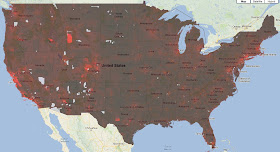The above is the distribution of US median house price (courtesy of
webfoot). The data is a little out of date - the 2000 census, so at the height of the dot com boom, and before both the mid 2000s housing bubble and subsequent crash. House prices are probably roughly back to where they were then, but some of the details will be wrong. The scale is 0-$500k (in 2000 $$).
My general feeling from staring at this is that we haven't gotten this Internet thing to work properly yet.
Here's a related map - this shows the ratio of median house price to median income, on a scale of 1 (blue) to 6 (red). A good value is about 3 (purplish), meaning that the median household can afford the median house (with the old rough rule of thumb that you can buy a house three times your gross income). Red regions have overheated housing markets where affordability is a problem. Blue regions are suffering from lack of housing demand (and are probably in trouble in other ways too).


As someone who once worked in real estate, this is probably a betrayal of my former profession, but shouldn't we be trying to make house prices as affordable as possible? I think Bush the younger had something about an "ownership society", which was one of the few decent things he ever said...
ReplyDeleteNo offense, certainly builders and real estate agents need to make a living, but housing should be cheap. Not "affordable", but cheap. In an ideal society, everyone would have housing and not have to put a very substantial portion of their income out to do it.
@adamatari:
ReplyDeleteVinay Gupta discusses the phenomena of cheap housing in this video:
http://vinay.howtolivewiki.com/blog/other/meaning-plausible-utopias-3192
He specifically covers the scenario where housing becomes so cheap it breaks the financial system.
I'm surprised to see how much of the West has 'the right problem' (if you'll excuse me for my assumptions.)
ReplyDeleteI thought the phenomena was significantly more coastal. I'm in the Rio Grande River valley, and land has stayed at ~$100k/arable acre through the 2008 housing crisis. Not quite the same as a house, but the metric that matters more to me, personally.
I wonder if this is a longer east=>west growth pattern or whether more near-term events are driving this phenomena.
@Alan Post
ReplyDeleteI think that the East to West price difference is mostly explained by population growth rates. Check out http://www.texastribune.org/2011/03/25/maps-visualize-us-population-growth-by-county/ with the origional source at http://www.census.gov/prod/cen2010/briefs/c2010br-01.pdf
Alan Post, that's a great video.
ReplyDeleteI say, let's break it! Throw it out - the financial system is a human construct. Human needs come first.
What we have now is a small owner class. What I am effectively preaching is land reform - real property reform, rather - and distribution of property to the masses.
I do understand that the financial system relies on this stuff (massive debt held by the middle class and rents flowing from the poor). That's why it broke before. Well, what would have happened if we had made the homeowners whole and replaced the failed banking system instead of the other way around?
I don't mind being a radical. Our current society is a failure.
On the question of whether housing should be cheap. I guess it depends on why. In upstate NY where I am, housing is generally pretty cheap by national standards, but it's not for a great reason - it's due to the loss of manufacturing jobs, and thus communities being in decline.
ReplyDeleteThe other thing worth point out is that the housing market is heavily regulated to limit how cheap things can get on the low end - the local governments won't let people live in shacks with tin roofs, but instead insist on housing that meets a very high standard (viewed from a long-term historical perspective). This cuts off the low tail of the housing distribution.
Stuart makes a good observation on zoning regulation. I designed and built an 800 square foot cottage here in rural Ohio. If we had zoning, it would have likely had to be a minimum of 1000 sq. ft.
ReplyDeleteI'm lucky to have been able to build such. Much of the "tiny house" movement is forced to build on trailers to avoid "enforced affluenza" zoning laws.